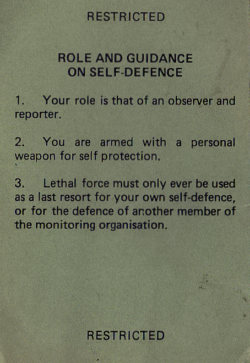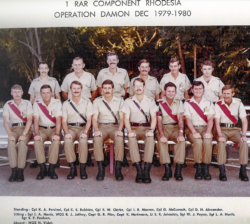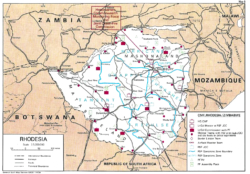‘PANGOLIN TIMES’ – Aussie Troops in Rhodesia Dec 1979 – Mar 1980.



From December 1979 until March 1980, the Australian Army carried out Operation DAMON, the Australian contribution to the Commonwealth Monitoring Force (CMF) in Rhodesia. The Australian component, consisting of officers and NCO’s drawn from various corps, formed part of a deployment made up of roughly 1500 troops, mainly from the Britain (1200 personnel), but with contingents also coming from New Zealand (76), Kenya (51) and Fiji (24).
The Commonwealth Monitoring Force, operating as part of Operation AGILA, (British codename) was formed to oversee the ceasefire between the Rhodesian Government’s Security Forces and 22,000 Patriotic Front guerrillas from Robert Mugabe’s Zimbabwe African National Union (ZANU) and Joshua Nkomo’s Zimbabwe African People’s Union (ZAPU) during the run-up to the 1980 general elections, which would establish the governance of a new independent state.
The CMF’s role was to monitor and report on compliance with the ceasefire from both sides and try to dissuade them from actions which might lead to a breach of the agreement. It was not required to enforce any aspect of the cease fire, and there was no requirement to disarm the warring factions.


The Australian contingent consisted of 152 members of the Australian Army who served in Rhodesia from 25 December 1979 to 5 March 1980. Preceding the main Australian contingent was an advance party consisting of five Australian Army officers, who arrived in Rhodesia on 23 December and departed on 30 December 1979. The bulk of the Australian commitment arrived on Christmas day.




Initially, five Popular Front assembly points were to be overseen by the Australians, most were inland from the Mozambique border and used by the Zimbabwe African National Liberation Army (ZANLA), the military wing of ZANU. The sites included Elim (which had attracted worldwide attention in 1978 after the rape, murder and mutilation of 12 missionaries and children by Robert Mugabe’s ZANLA terrorists), Magadze, Marymount and Dendera, in the north-east, and Kari-Yangwe, in the north-west of the country. Other Australians were deployed with the Rhodesians at Mount Darwin, Bindura, Mtoko and Sinoia.
Of the Australians (27 officers and 109 NCO’s) were deployed to the Patriotic Front assembly points, or to monitor the activities of the Rhodesian Security Forces, whilst the remainder comprised the headquarters element (4 officers including one medical officer and 11 SNCO’s).



The force was spread thin and would be vulnerable should the peaceful transition to independence fail. In an interview given to The Age at the start of the deployment, Australian contingent commander, Colonel Kevin Cole described the risk as fourfold, “disease, wild animals, land mines, and the chance of a deliberate or accidental breakdown in the ceasefire.” If a breakdown in the ceasefire did occur, the CMF teams at the Assembly Points, which consisted of an officer with sixteen other ranks armed with rifles plus one GPMG could be in real trouble.





In the lead up to the election there were several breaches of the ceasefire and attempts to intimidate the monitors, but all situations were resolved without the use of force. There were also environmental hazards, including a wide range of diseases and the existence of landmines within the areas in which they had to work. There were many breaches of the ceasefire and acts of intimidation by both sides in the lead-up, but the election went ahead over three days, 27–29 February, without major incident. Robert Mugabe’s ZANU faction broke the terms of the Lancaster House Conference by keeping half his fighters in the field, outside of the Assembly Points as was required the agreement. This resulted in widespread voter intimidation but did not stop the election from proceeding as planned and his party won a decisive victory. Rhodesia was officially renamed Zimbabwe on 18 April 1980 with Mugabe its new prime minister. On 2 March 1980, CMF personnel were pulled back to a camp in and around New Sarum Airport and were flown out over the following days with the Australians returning home on 5 March.

Postscript:
Almost as soon as the CMF left Rhodesia, Robert Mugabe started to settle old scores and consolidate his power by having his henchmen target his ‘comrade’ Joshua Nkomo’s ZAPU faction. The deep-seated rivalry of the two liberation parties was predicated on ideological and ethnic factors, ZANU being drawn largely from the Shona people and Nkomo’s ZAPU being Ndbele. Over the following month the murders escalated with open warfare occurring between the groups in Entumbane, a suburb of Bulawayo in November 1980. This was only quelled when the white led British South African Police intervened on the part of the government. Then, in February 1981 open fighting once again erupted in Bulawayo between Mugabe’s ZANLA and ZIPRA, the military wing of ZAPU. This also spread to Essexvale and Gwelo where ZANLA cadres at Connemara Barracks surprised their ZIPRA counterparts, killed over 60 of them and forced the rest to flee into the bush. ZIPRA mobilised armour for their operations against the ZANU fighters. Once again, Mugabe had to call upon the professional white-officered black regulars of the 1st Battalion Rhodesian African Rifles, Rhodesian Armoured Car Regiment and (although unauthorised) Air Force to crush ZIPRA. Alexandre Binda, in his book Masodja: The History of the Rhodesian African Rifles and Its Forerunner, the Rhodesia Native Regiment, states that over 400 guerillas were killed with no fatal casualties to the government troops. Ironically, Mugabe and ZANU–PF were once again saved from a major rebellion by white-led ex-Rhodesian troops.

.
But the rebellion’s defeat caused mass desertions from former ZIPRA fighters and Joshua Nkomo, who had been given a ministerial post (without a portfolio) in Mugabe’s cabinet, was removed from office in February 1982 after being accused of planning to overthrow Mugabe. Shortly after independence, in October 1980, North Korea offered to train a unit of Zimbabwe’s army that would be responsible for crushing political dissent and reporting directly to Mugabe. In August 1981 106 North Korean advisors arrived and began work creating the infamous Fifth ‘Gukurahundi’ Brigade, which graduated in December 1982. These troops were then deployed in Matabeleland, beginning a campaign known as Gukurahundi, which in Shona means “early rain that washes away chaff.” The four year-long campaign resulted in around 20,000 (although some estimates put the figure at 30,000) civilians being killed. It officially ended in December 1987 when Nkomo signed a unity accord merging ZAPU into ZANU-PF and consolidating Mugabe’s absolute grip on power until the 2017 coup.


2 Comments
Comments are closed.











Great article, Jules. By chance, I have also come across some interesting pics taken by then CPL Joe Linford RAAC of his time as an Aussie observer. Joe would, later on, become the WO curator of the RAAC Museum at Puckapunyal for many years.
Cheers mate. I’m not sure of the total number of RAAC personnel who were in the contingent, but there was also a RAAC SNCO, sgt Butts, at my first posting in Holsworthy who was also part of the deployment. Never spoke to him about it though, as a newbie digger, he just struck me as a grumpy old SNCO who needed to be avoided at all costs.